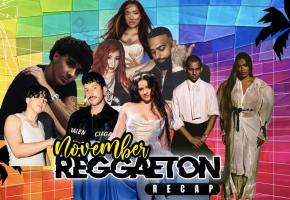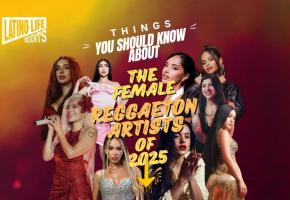It’s 2050 and you are dancing like no one is watching, no pressure or expectations, and we are free to be exactly who we are, all whilst dancing a new hybrid of what used to be called reggaetón. This is ne-perreo; more than just a musical genre, it’s a movement, a female-led phenomenon. It’s reggaetón for misfits; reggaetón for the non-binary age.
The phenomenon blew up with digital and music creatives Ms Nina from Argentina and Chilean Dj Lizz, but the term neo-perreo was first created by musician and composer Valeria Cisternas aka Tomasa Del Real, now considered to be the matriarch of the movement. So what is neo-perreo exactly?
“It’s like twerking,” Tomasa explains. “Perreo means twerk, but it’s not regular twerk it’s a new twerk. The new wave of twerk, because the perreo twerk is just for girls with big asses, but neo twerk is for everybody. It’s about the dance, not the music. You can perrear to anything, it’s about the feeling, not just a thing girls do for boys.”
Tomasa was born in Iquique, on the very northern coast of Chile, close to the Atacama desert, “closer to Peru than Santiago” as she explains. She began tattooing professionally since 2011, whilst starting to make reggaetón music with a network of people online, who enjoyed making music and combining other digital aspects. Whilst travelling for her tattoo work, for which she had a shining reputation, people began to ask her to perform at events or record music together, and thus began the movement, hashtag and events.
“It all began as a coincidence,” Tomasa says. “ Because as a girl from Iquique there was no place to dance reggaetón with my friends. All my friends are ‘strange’, by that I mean one is a metal head, another who is gay, I dress strange, one is rich, one is poor and steals, and we had nowhere to dance reggaetón because we didn’t fit the profile. We all loved the music, but there was no place we could all go and not be divided, that’s how the neo-perreo events started, we created a place where everyone was welcome, from the quiet one to the loud one. In a neo-perreo event, there isn’t that pressure of trying to impress the opposite sex like in normal clubs. In Chile, normal reggaetón events wouldn’t have me perform because I was too strange and in alternative clubs, I was too reggaetonera. There was a specific place in Santiago called Mamba, which is closed now but they did the first neo perreo events so that I could perform somewhere, and we gave it that name so people felt comfortable coming in.”

It wasn’t just coincidence, however, for Tomasa was making music long before neo-perreo came along.
“I started making music many years ago. I had a band called “Ponciaoculta.” I have always loved art, and one day for fun I started singing because my mom had bought be me a MacBook air, so I started exploring the programs like photobooth and Garage band-really simple stuff. I started making music with videos and I would upload it on YouTube. Other artists loved it and they contacted me to create videos and collaborate, a lot of people supported me in that moment. I loved being creative and I made songs that people loved so I suddenly became a singer and I never stopped.”
Though originally organized in Chile, the neo-perreo events quickly spread throughout South America, distinguishing themselves from ‘normal’ reggaetón parties with a different type of aesthetic, more futuristic, dark and digital. Eventually, Tomasa says, “the events got so huge that we travelled all over the world to do these events, we did South America, Europe and United states. I need to go to London, invite me! I’ve even performed in Vienna.
The internet is something that comes up a lot in the conversation. Online networking was the way they shared their work with other creatives around the world who liked the music and vibe.
“Being from a small city, I was lucky my parents always made sure we had internet, so I was connected. I feel that I’m from Iquique but I’m also from the internet, which has kind of turned into a country of its own where the artists like myself and Ms Nina who are famous, not Daddy Yankee can share their work. So the evolution has been 100% down to the internet. Obviously in my city I had fun and I did some shows but never it got to the massive level I reached through the internet”
This is the new generation of musical creatives that makes neo-perreo distinct; a bringing together of all types of people who are not usually associated with reggaetón. A place for people who might not feel comfortable in reggaetón clubs, with their defined gender roles and oversexualised expectations of women.
“It’s difficult to find spaces where everyone can fit. Like if you’re gay you have to be with your gay friends,” Tomasa explains. “And we’re like ‘no, I don’t care who you fuck, I just want to do dance with my friends.’ Music is for everyone regardless of lifestyle, I listen to songs about drugs whilst going shopping. Generations have been opening doors and teaching new things, reggaeton taught me that being sexual is not a bad thing.”

Far from the self-conscious and hyper consumerist confines of the traditional reggaetón scene, Tomasa argues, where everyone has to conform to an aesthetic and there is only one way to look good, the neo-perreo is a liberating experience, a place you can be who you want, or take on the identity you want, owning your own world. It’s about turning stereotypes and prejudices on their head as did Tomasa herself.
“At home I was always called ‘La Negra’ my mum used to call me la negrita, because you know, we’re from the desert. It’s not an insult, sometimes people might think referring to someone (of colour) as ‘Negra’ is a bad thing, which I understand, but where I am from its not an insult, its normal. So, everyone always called me la Negra, as time went by my friends started called me la Negra Tomasa, like the women who carry fruits baskets on their head, and I loved it because it has a masculine connotation from the name Tomas. So, I decidd to use it. I really liked this band called Teleradio Tenoso which was a Chilean Indie band, nothing to do with reggaeton. One of the members is called Martin del Real and I thought that name was the best thing in the world, so I stole it! I own that name now and I am that. So, it has another meaning changing my name, because you are owner of your life no matter what. A new generation of ‘Reales’.”
This is the key to neo-perreo’s success, a way for a broader audience to enjoy reggaeton together, a progessive space to allow self-expression, that empowers women and men to embrace sensuality without any shame. But, while the movement was clearly a reaction to the macho origins of reggaetón and lack of female voices in the genre, it’s clear that the reaction has also had an impact on mainstream reggaetón, with many more women in the genre and with artists like Bad Bunny condemning homophobia and transphobia.
“Before, most of the voices in reggaetón were always men and women could feel like it’s a dangerous area, this safe space has been growing more and more. Even during quarantine, its still growing and we aren’t even doing events. Or when someone uploads a song and they call it neo-perreo, they use the concept to describe it, it’s like a verb now.”

And with success the brands have come calling, Tomasa has modelled for adidas.
“For me Neo Perreo is a subculture and so it is a proud moment that the ainstream is embracing its and these big brands are contacting me to sell their stuff, because of course big brands represent a select group of people who are dying off, the old mindset people, boring people, people who dress bad, racist and homophobic people. These reactionary people are a dying breed, they need new generations, more open minded and modern, so they call me because I represent that group, the people in the future not in the past. So, I love it.”
So with all this success has Iquique grown to small for Tomasa del Real?
“I’ve travelled a lot, I lived in Mexico and Argentina, Now I live in LA for the last 3 years, but my culture is Atacamenian (people who are from the Atacama desert, the driest Desert in the world), and that is where I am from, my culture is really special. I’m not even from a big City, like in Mexico where you need to be from DF (Mexico City) or like In Chile where you need to be from Santiago to achieve something great, but I’m from Iquique, no one knows where it is! Hopefully people Google it now so they can see how beautiful it is. Its actually on the beach and they call it the Miami Chileno because it has a lot of life and Fast and Furious type of cars, that kind of thing, very kitsch. Its super Miami vibes, so google it!”
There it is, neo-perreo explained by the pioneer herself. As always, we misjudge at first, neo-perreo seemed like an aesthetically pleasing clan for vain lovers of the strange, but it is so much more than that. Female dominated reggaetón sub genres like neo-perreo are important for creating safe spaces for other sub-cultures within reggaetón, and most importantly, a space for everyone to enjoy reggaetón in the new way.
Tomasa del Real performs at the Jazz Cafe on Saturday 9th July. Tickets here https://thejazzcafelondon.com/event/tomasa-del-real/



















